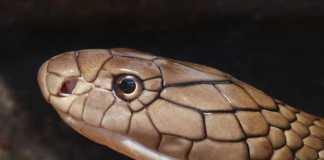Curious about the senses of Snakes? You’ve reached the right place. From looking at a snake, you can see that it doesn’t have ears, but yet a snake can hear up to 1000 HZ and uses its sense of hearing to locate prey. Snakes also have an excellent sense of smell, yet they certainly don’t have a conventional nose to smell with. A snake’s sense of smell and hearing makes up for the fact that they have relatively poor eyesight. Snakes are incredibly efficient at using their senses to detect their lunch, and this is what makes them so successful as predators.
How snakes hear
The snake’s sense of hearing isn’t like ours, they generally don’t hear airborne sounds very well – this is why if you talk to a snake, it is unlikely to respond to you (unless you’re Harry Potter). The anatomy of a snake means that it simply doesn’t have ear holes to listen through. They don’t have an outer and middle ear either, but they do have an inner ear that is located at the top of their head in the cranial area. Snakes process sound differently from humans with a narrower range of highs and lows. They can, however, feel vibrations very effectively. They do this through their jawbones and their skull. The sound of a small mouse running may be very quiet to you and me, but a snake can hear the vibrations of the mouse and use these sounds to stalk its prey.
How snakes smell
A snake’s sense of smell is its most effective tool in finding food. Snakes don’t have a nose though, instead, they use their tongue and a sensory organ called the Jacobsen’s organ, which is located on the roof of their mouth. A snake’s forked tongue efficiently picks up scent particles within the air and transfers them to the Jacobsen’s organ. From there, the information is transferred to the brain to interpret. Incredibly, a snake can determine from the scent particles whether he is smelling a threat or an important food source. So next time you see a snake flicking its forked tongue, you will know that it is picking up the scent particles from the air to explore its environment and look for essential food.
How snakes see
The anatomy of a snake’s eye is different from humans. One of the main differences is within the cells of the eyes, which are called cones and rods. The cones affect how we see and process color. The cones in human eyes react to three different wavelengths, allowing us to see three primary colors, red, yellow and blue. A snake can only see two different wavelengths, blue and green, so its vision is dichromatic. Snakes however are sensitive to UV light, this helps them to see their prey in the dark, perfect for a spot of night hunting.
A snake’s anatomy means that they process sound, smell, and light very differently from humans. They have evolved this way to help them survive in harsh environments and still be able to find a meal.

Marie Miguel has been a writing and research expert for nearly a decade, covering a variety of health-related topics. Currently, she is contributing to the expansion and growth of a free online mental health resource with Mind-Diagnostics.org. With an interest and dedication to addressing stigmas associated with mental health, she continues to specifically target subjects related to anxiety and depression.



